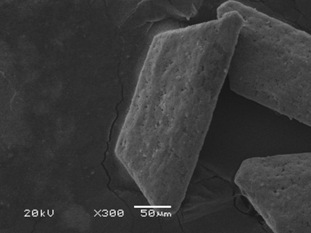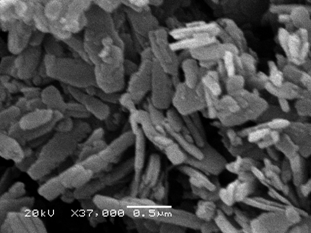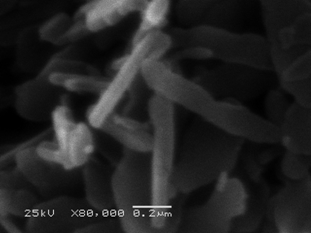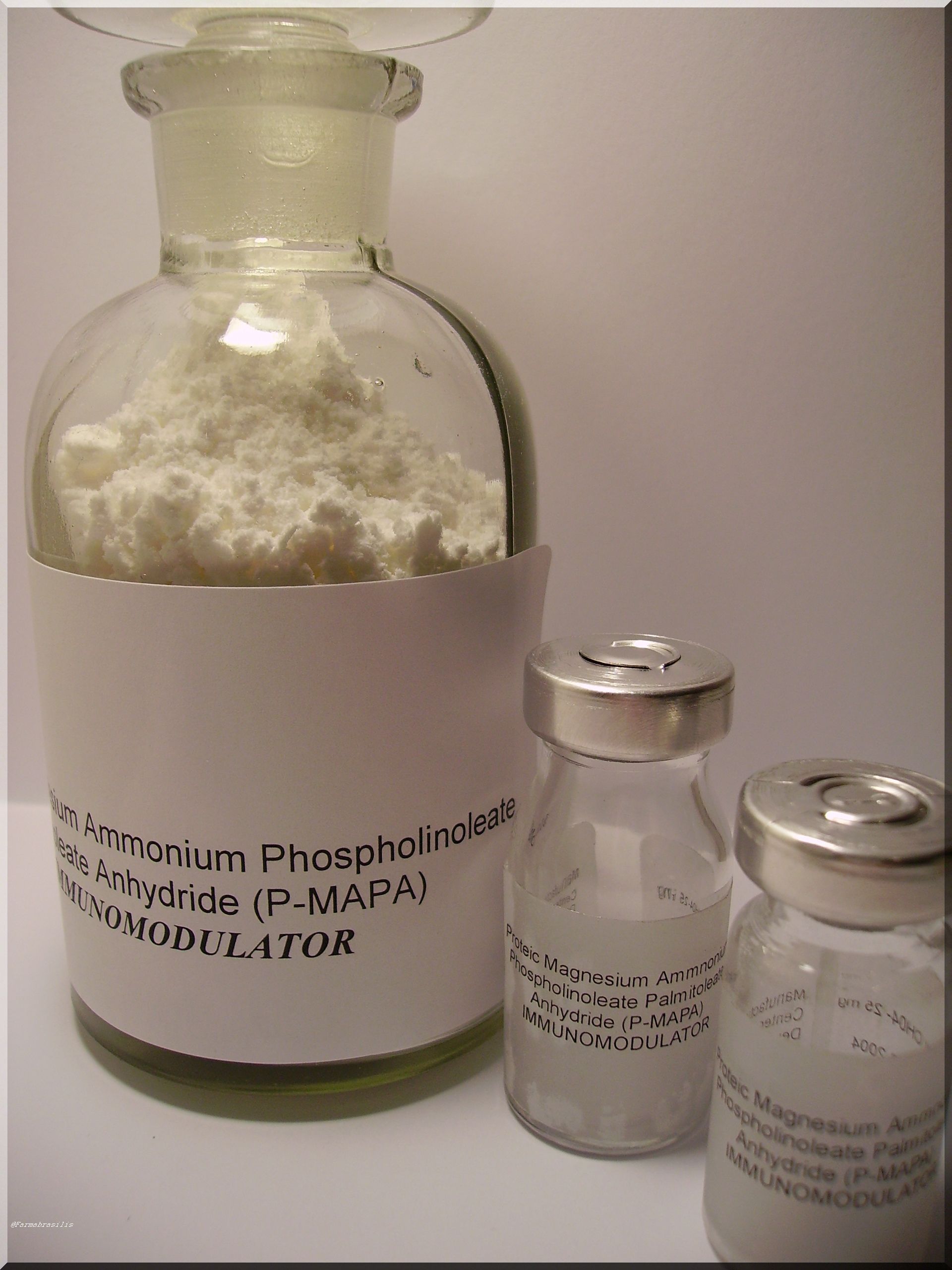Strengthening our natural defences: a new drug candidate and a new approach to fighting infectious diseases
By Carlos Fioravanti
State University of Campinas
A versatile new drug candidate called P-Mapa along with a new proposal to fight infectious diseases have emerged in Brazil. They are the result of collaboration among non-academic and academic groups in Brazil, Chile and the US led by the non-profit research network Farmabrasilis.



Figure 1. Crystals (300 x) and nanocrystals (37,000 and 80,000 x) of P-Mapa: an immunomodulator derived from Aspergilus orizae (Credit: Courtesy Farmabrasilis)
P-Mapa, a proteinaceous aggregate of ammonium and magnesium phospholinoleate-palmitoleate anhydride, is a biotechnological compound derived from Aspergilus orizae [1]. It is an immunomodulator, which can rebuild the organism’s natural defence system against tumours, viruses, bacteria and other disease-causing microbes.
P-Mapa has demonstrated anti-tumor activity, with no relevant signs of toxicity, on studies performed on rodents, non-human primates and on HIV-positive patients-phase I clinical trial [2,3,4]. The compound was shown to induce proliferation of lymphocyte T, increase cytokine production and natural killer cell activity, and stimulate nitric oxide release by macrophages [5,6,7].
Scientists from the Brazil-based Farmabrasilis and the US National Institute of Allergy and Infectious Diseases (NIAID) have confirmed the potential of P-Mapa to treat infectious diseases. In 2009, Farmabrasilis and NIAID teams showed that P-Mapa can protect against Punta Toro Virus (PTV), which produces a fatal hepatic disease in animals and is closely related to the Rift Valley fever virus, endemic in sub-Saharan Africa. In these experiments P-MAPA was compared to the antiviral Ribavirin. Both were able to protect 100% of all infected animals with no signs of hepatic damage, strengthening the possibility of using P-Mapa as adjuvant to treat hepatitis B and C, mainly when the first-choice medicine has limited use or with adverse effects [7,8].
The latest tests carried out by Brazilian and American teams have demonstrated that P-Mapa is active against Mycobacterium tuberculosis in vivo. Wild-type C57BL/6 mice were exposed to an aerosol of M. tuberculosis and later treated with P-Mapa and the antimicrobial Moxifloxacin, used both alone and together. The P-Mapa acted alone to deter the bacterial proliferation in the lung and spleen at levels above the minimum standards required. P-Mapa may have synergized with Moxifloxacin, as the combination of the two drugs provide wider protection than each when used alone [9].
A plan to fight infectious diseases
Based on these data, the Farmabrasilis team proposed the use of P-Mapa to fight infectious diseases. Launched in 2009 at 3rd Stop TB Partners Forum, the proposal focuses on the re-establishment of the patients’ natural defenses (immunocompetence) by using P-Mapa as an adjuvant medicine with antiviral and antimicrobial drugs. This approach could help to prevent or treat diseases such as tuberculosis and malaria in patients, including those co-infected with HIV.
The Farmabrasilis proposal includes the possibility of sharing all data and methods of production, free of charge, with governments, institutions or groups interested in using the P-Mapa to treat neglected diseases and disadvantaged populations. In such cases, partners cannot sell the medicines or the technologies associated with them, and must also offer the medicine free of charge to people who most need them, as detailed on the Farmabrasilis website [10].
Broader than other approaches from other Public-Private Partnerships, Farmabrasilis’ call for a collective, open task force against infectious diseases represents a way to reduce the cost of drug development whilst engaging civil society organizations in the search for new models of medicine research and production [11,12].
A collective effort
In its use of non-academic and academic groups, from discovery to the first human trials, the P-Mapa course illustrates innovative ways to produce scientific knowledge. This approach can reduce the time and the money usually required to develop a new drug, as well as to conciliate interests from different groups and help to solve public health needs.
This strategy can be significant especially in developing countries. In Brazil, most drug candidates discovered in research institutes hardly go beyond the publication of papers, and Brazilian pharmaceutical companies only produce drugs derived from plants (used as analgesic or anti-aging agents), me-too compounds (e.g., to treat erectile dysfunction) or generic medicines, rarely addressing the public health needs [13,14].
As part of my doctoral research, I have followed 26 molecules presented over the past 15 years in international scientific journals and in Brazilian newspapers and general magazines as promising medicines. The molecules represented new hope against cancer, tuberculosis, pain, inflammation, arterial hypertension, Alzheimer’s disease, arthritis, epilepsy, mycosis, and ulcers, as well as typically tropical health problems such as Chagas disease and schistosomiasis. The scientists responsible for the research have stated, through the media, that these molecules would be evaluated in humans or be available as medicine in a few years. For various reasons, until 2010 none of the molecules has reached the promised goals.

Figure 2. P-Mapa purified: a medicine in the pipeline (Credit: Courtesy Farmabrasilis)
An unusual story
P-Mapa has had an unusual story. Initially, the physician Odilon da Silva Nunes worked for almost 40 years in a private laboratory, away from formal science research centers, to develop a molecule that could block tumors, according to his own hypothesis about the origin of cancer. The research advanced through collective work by other physicians and both non-academic and academic researchers who evaluated the compound’s properties according to drug development guidelines. In the 1990s, Farmabrasilis teams, led by Dr. Iseu Nunes, scaled up the production and tested the compound on a group of HIV-positive people. Next, unable to forge alliances with pharmaceutical companies in Brazil, the research group reorganized, grew internationally and focused the research on infectious diseases, especially the most common in poor countries, such as AIDS and tuberculosis.
As a science writer and later as a PhD candidate, I have followed the P-Mapa story since 1991. I was privileged to visit the laboratories where P-Mapa was produced and talk to the scientists involved in this research. Their motivation to work voluntarily was “to satisfy idealism or curiosity, seek new challenges, hone skills, build a reputation or enhance careers”, as in other open source researches [15].
In 2007, as a Reuters Institute for the Study of Journalism Fellow at Oxford University, I examined how penicillin emerged in London and was later developed at Oxford. After comparing the course of the English and the Brazilian compounds, I concluded that their development is similar. Briefly, both started in the hands of physicians, moved ahead through a multidisciplinary task force and required overseas aid to be concluded [16]. However, the P-Mapa effect is broader, due to its ability to deter tumours, viruses and bacteria. Unlike penicillin, P-Mapa is a medicine in the pipeline.
References
1. Nunes I et al. United States Patent Application: US20060093628. “Protein aggregate magnesium-ammonium phospholinoleate-palmitoleate anhydride immunomodulator, its production process and formulation”.
2. Justo GZ, Durán N, Queiroz MLS. Myelopoietic response in tumor-bearing mice by an aggregated polymer isolated from Aspergillus orizae. Eur. J. Phamacol. 1999, 388: 219–226.
3. Farmabrasilis. P-MAPA toxicity and safety. Available from: www.farmabrasilis.org.br/todos conteudos interna.php?idioma=eng&id=217. [Accessed: 22th June 2010]
4. Farmabrasilis. P-MAPA clinical trial phase I. Available from: www.farmabrasilis.org.br/interna relatorios clinicos.php?idioma=eng&id=180 [Accessed: 22th June 2010]
5. Melo A, Justo GZ, Queiroz MLS. Stimulation of myelopoiesis in Listeria monocytogenes-infected mice by an aggregated polymer isolated from Aspergillus oryzae. Human Exp. Toxicol. 2001, 20: 38–45.
6. Justo GZ, Durán N, Queiroz MLS. Natural killer cell activity, lymphocyte proliferation and cytokines profile in tupour-bearing mice treated with MAPA, a magnesium aggregated polymer from Aspergillus orizae. Immunopharmacol. Immunotoxicol. 2003, 25: 305–319.
7. Farmabrasilis. P-Mapa Product Monograph. Available from: http://www.farmabrasilis.org.br/todos_conteudos_interna.php?idioma=eng&id=110 [Accessed: 22th June 2010]
8. Durán N, Gowene BB et al. A biotechnological product and its potential as a new immunomodulator for treatment of animal phlebovirus infection: Punta Toro virus. Antiviral Res. 2009, 83: 143–147.
9. Farmabrasilis. Assessment of the efficacy of the immunomodulator P-MAPA against M. tuberculosis in a standard mouse model. Available from: http://www.farmabrasilis.org.br/todos_conteudos_interna.php?idioma=eng&id=276 [Accessed: 22th June 2010]
10. Farmabrasilis. Infectious diseases proposal. Available from: http://www.farmabrasilis.org.br/pesquisa_desenvolvimento_interna.php?idioma=eng&id=255 [Accessed: 22th June 2010]
11 Rawlins MD. Cutting the cost of drug development? Nat. Rev. Drug Discov. 2004, 3: 360-364
12 Bhan A, Singh JA et al. Grand Challenges in Global Health: Engaging Civil Society Organizations in Biomedical Research in Developing Countries. PLoS Med. 2007, 4(9): e272.
13. Rezaie R, Frew S et al. Brazilian health biotech—fostering crosstalk between public and private sectors. Nat. Biotechnol. 2008, 26: 627-644.
14. Vidotti CC, de Castro LL, Calil SS. New drugs in Brazil: Do they meet Brazilian public health needs? Rev Panam Salud Publica. 2008, 24(1):36-45.
15. Munos B. Can open-source R&D reinvigorate drug research? Nat. Rev. Drug Discov. 2006, 5, 723-729.
16. Fioravanti C. New perspectives on drug development in developing countries: A case study of the Brazilian compound P-Mapa. Reuters Institute for the Study of Journalism 2007. Available from: http://reutersinstitute.politics.ox.ac.uk/fileadmin/documents/Publications/fellows__papers/2006-2007/NEW_PERSPECTIVES_ON_DRUG_DEVELOPMENT_IN_DEVELOPING_COUNTRIES.pdf [Accessed: 22th June 2010]







 Send to a Friend
Send to a Friend Print
Print Back
Back